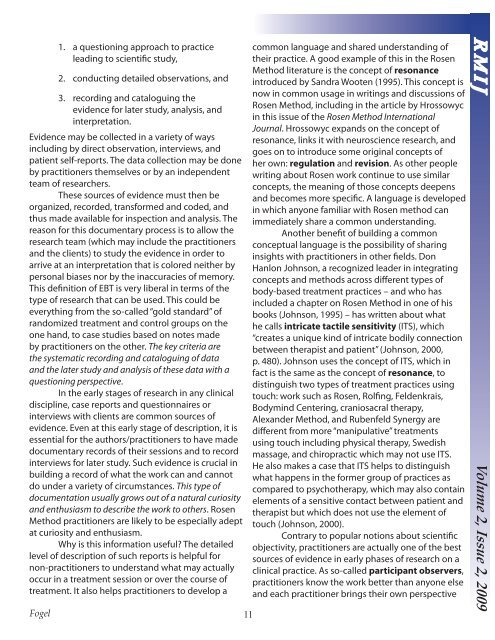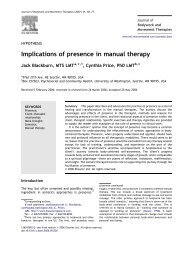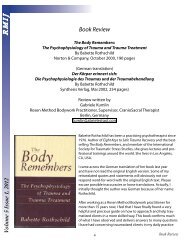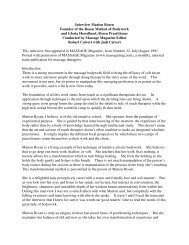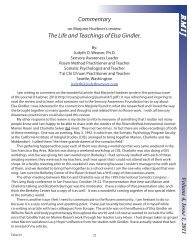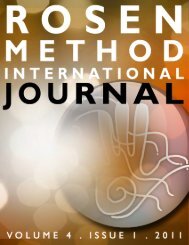RMIJ ... - Rosen Journal
RMIJ ... - Rosen Journal
RMIJ ... - Rosen Journal
Create successful ePaper yourself
Turn your PDF publications into a flip-book with our unique Google optimized e-Paper software.
Fogel<br />
1.<br />
2.<br />
a questioning approach to practice<br />
leading to scientific study,<br />
conducting detailed observations, and<br />
3. recording and cataloguing the<br />
evidence for later study, analysis, and<br />
interpretation.<br />
Evidence may be collected in a variety of ways<br />
including by direct observation, interviews, and<br />
patient self-reports. The data collection may be done<br />
by practitioners themselves or by an independent<br />
team of researchers.<br />
These sources of evidence must then be<br />
organized, recorded, transformed and coded, and<br />
thus made available for inspection and analysis. The<br />
reason for this documentary process is to allow the<br />
research team (which may include the practitioners<br />
and the clients) to study the evidence in order to<br />
arrive at an interpretation that is colored neither by<br />
personal biases nor by the inaccuracies of memory.<br />
This definition of EBT is very liberal in terms of the<br />
type of research that can be used. This could be<br />
everything from the so-called “gold standard” of<br />
randomized treatment and control groups on the<br />
one hand, to case studies based on notes made<br />
by practitioners on the other. The key criteria are<br />
the systematic recording and cataloguing of data<br />
and the later study and analysis of these data with a<br />
questioning perspective.<br />
In the early stages of research in any clinical<br />
discipline, case reports and questionnaires or<br />
interviews with clients are common sources of<br />
evidence. Even at this early stage of description, it is<br />
essential for the authors/practitioners to have made<br />
documentary records of their sessions and to record<br />
interviews for later study. Such evidence is crucial in<br />
building a record of what the work can and cannot<br />
do under a variety of circumstances. This type of<br />
documentation usually grows out of a natural curiosity<br />
and enthusiasm to describe the work to others. <strong>Rosen</strong><br />
Method practitioners are likely to be especially adept<br />
at curiosity and enthusiasm.<br />
Why is this information useful? The detailed<br />
level of description of such reports is helpful for<br />
non-practitioners to understand what may actually<br />
occur in a treatment session or over the course of<br />
treatment. It also helps practitioners to develop a<br />
11<br />
common language and shared understanding of<br />
their practice. A good example of this in the <strong>Rosen</strong><br />
Method literature is the concept of resonance<br />
introduced by Sandra Wooten (1995). This concept is<br />
now in common usage in writings and discussions of<br />
<strong>Rosen</strong> Method, including in the article by Hrossowyc<br />
in this issue of the <strong>Rosen</strong> Method International<br />
<strong>Journal</strong>. Hrossowyc expands on the concept of<br />
resonance, links it with neuroscience research, and<br />
goes on to introduce some original concepts of<br />
her own: regulation and revision. As other people<br />
writing about <strong>Rosen</strong> work continue to use similar<br />
concepts, the meaning of those concepts deepens<br />
and becomes more specific. A language is developed<br />
in which anyone familiar with <strong>Rosen</strong> method can<br />
immediately share a common understanding.<br />
Another benefit of building a common<br />
conceptual language is the possibility of sharing<br />
insights with practitioners in other fields. Don<br />
Hanlon Johnson, a recognized leader in integrating<br />
concepts and methods across different types of<br />
body-based treatment practices – and who has<br />
included a chapter on <strong>Rosen</strong> Method in one of his<br />
books (Johnson, 1995) – has written about what<br />
he calls intricate tactile sensitivity (ITS), which<br />
“creates a unique kind of intricate bodily connection<br />
between therapist and patient” (Johnson, 2000,<br />
p. 480). Johnson uses the concept of ITS, which in<br />
fact is the same as the concept of resonance, to<br />
distinguish two types of treatment practices using<br />
touch: work such as <strong>Rosen</strong>, Rolfing, Feldenkrais,<br />
Bodymind Centering, craniosacral therapy,<br />
Alexander Method, and Rubenfeld Synergy are<br />
different from more “manipulative” treatments<br />
using touch including physical therapy, Swedish<br />
massage, and chiropractic which may not use ITS.<br />
He also makes a case that ITS helps to distinguish<br />
what happens in the former group of practices as<br />
compared to psychotherapy, which may also contain<br />
elements of a sensitive contact between patient and<br />
therapist but which does not use the element of<br />
touch (Johnson, 2000).<br />
Contrary to popular notions about scientific<br />
objectivity, practitioners are actually one of the best<br />
sources of evidence in early phases of research on a<br />
clinical practice. As so-called participant observers,<br />
practitioners know the work better than anyone else<br />
and each practitioner brings their own perspective<br />
<strong>RMIJ</strong> Volume 2, Issue 2, 2009


